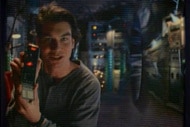Create a free profile to get unlimited access to exclusive videos, sweepstakes, and more!
Star Trek's warp speed travel would have tragic consequences

The universe is big. Like, really big. Bigger, even, than several IKEAs strung end to end, if you can believe it. It's so big that just getting to the Moon, which seems so close sometimes you feel like you could reach out and grab it, takes a few days. Getting to Mars, our best candidate for setting boots on another world, is an even worse prospect. The numbers get a little wiggly, owing to the constant movement of the two involved planets, but a crewed trip to Mars, using current technology, would take about nine months. That's quite a road trip.
The point is, there's a whole lot of space out there and getting anywhere interesting takes way too long. We are a society hell-bent on immediate gratification. It's why instant noodles exist.
Science fiction writers have imagined all sorts of solutions for this specific problem. Waiting decades or centuries for our protagonists to arrive on another world can make for stagnant storytelling, so we've dreamed up hyper-drives and subspace tunneling. Perhaps most famous among these fictional solutions is Star Trek's warp drive.
In the 23rd and 24th centuries, traveling to the edges of the cosmos is as simple as pushing a button, presuming you've got a well-stocked store of dilithium crystals. The enlisted members of Starfleet enjoy spacecraft capable not only of moving at a significant fraction of light speed but of dispensing with this universal constant altogether. Who needs relativity, anyway?
It makes for better storytelling. The various crews of Trek's slate of television shows and movies can get from here to there without much fanfare. Seeking out new worlds and new civilizations is no more difficult than gassing up the car and packing a cooler full of junk food. And they don't even need to do that! The replicators will crank out a bologna sandwich just like mom used to make. All that's left is to go, but what happens then?
Say goodbye to your friends and family, we're about to explore the cost of traveling at warp speeds.
THE UNSEEN IMPLICATIONS OF FASTER-THAN-LIGHT TRAVEL
The crews of our favorite Star Trek shows regularly travel at velocities far outpacing the speed of light. Warp one, a veritable snail's pace in the world of Trek, is equal to the speed of light. Warp speeds exceeding warp one equal a multiple of C (the speed of light), but the exact speeds are variable, depending on the source material. It seems the Federation altered its scale as time went on.
Still, the fact of the matter is, our favorite Starfleet crews regularly traveled well beyond the speed of light as they whizzed between one planet and another.
In order to understand the implications of this type of space travel, we first have to have a basic understanding of relativity.
Previous to Einstein, the common belief was that time was constant, experienced by all observers, in all places, in the same way, and at the same rate. The trouble began when physicists realized that the speed of light is constant, regardless of the velocity of the observer. This differed from the way we experience velocities of pretty much anything else.
For instance, if a cannon fires a cannonball at 100 miles per hour, from atop a moving train also moving at 100 miles per hour, in the same direction, the total velocity of the cannonball is 200 miles per hour. This sort of relationship makes logical sense from our everyday perspective. But this same relationship does not apply to light.
Light shone from a stationary flashlight travels across space at 299,792,458 meters per second. If we were to strap that flashlight to the top of that same moving train traveling at 100 miles per hour (or 44.704 meters per second), the speed at which the light would travel remains at 299,792,458 meters per second. There is no apparent change to the light's total speed.
Where things get weird is when we realize that the apparent speed remains constant both for someone standing on the train and a stationary person standing on the platform.
No matter your perspective and against all common wisdom, the speed of light remains the same.
Einstein realized that the only way to reconcile these two divergent experiences was to modify the experience of time. In order for the speed of light to remain constant, the person traveling at faster speeds has to experience time more slowly. While it might seem counterintuitive, this conclusion is born of real-world experience.
Astronauts living on the International Space Station experience time at a slower rate than their counterparts here on Earth. Their speed, while impressive (4.76 miles per second), is slow when compared to the speed of light. As such, the time dilation they experience is minimal. Astronaut Scott Kelly spent a year on ISS, while his twin brother stayed here at home. After a year at those speeds, he would have aged about 0.01 second less than his brother. It's something, but they can still celebrate birthdays together without any trouble.
Things get weirder when you get nearer to the speed of light. The closer you get to the speed of light, the slower time moves for you. Time remains at the usual rate for the people back here on Earth.
If you were able to travel to Alpha Centauri, roughly 4.25 light years away, at 99.9 percent the speed of light, you'd be able to see the time dilation more clearly. The trip would seem, from the perspective of an observer on Earth, to take a little more than 4.25 years. For someone on the ship, however, the travel time would be a little more than five days. They could travel there, do a bit of research, and come back in less than a fortnight. But everyone here at home would have aged more than eight years.
Star Trek avoids all this trouble through a whole lot of hand-waving about warping spacetime.
It's not an entirely unfounded idea. In 1994, physicist Miguel Alcubierre proposed the possibility of bending spacetime around an object. By condensing the space ahead of a craft and inflating the space behind, you could create a bubble within which a craft could travel without violating relativity. The upshot is that anyone inside could travel effectively faster than the speed of light without experiencing any time dilation. In scientific circles, that's referred to as getting to have your cake and eat it, too.
That's all a little too clean for our tastes. If we've learned anything from the universe, it's that it doesn't like to make things easy for us. So let's assume we're at the mercy of relativism, just for fun.
THE COST OF THE ENTERPRISE
We've already discussed the implications of moving at a significant fraction of C. You can pretty much say goodbye to any relationships you have at home as soon as you sign on to a Starfleet ship. After just a couple of trips to nearby stars, everyone you know and love will be dead while you haven't even been at work long enough to collect benefit time.
Things get even weirder when your captain calls down to engineering to kick in the juice. Once you're traveling faster than warp one, things get totally bizarre.
The speed of light has an intrinsic relationship with causality. Once you go beyond it, the past, present, and future get a little wibbly-wobbly. We won't get into the mathematical weeds here. If you want a moderately simple explanation, check out the below video from PBS, but suffice it to say that once you get sufficiently beyond the speed of light, time goes totally out the window.
It's possible, at least hypothetically, once you're traveling at post-light speeds, to travel backward in time. There was some controversy about this a few years ago when, for a brief moment, scientists thought they might have observed superluminal neutrinos. In common terms, they thought they might have seen particles appearing before they were expected. Eventually, it was determined that there were mechanical errors that resulted in inaccurate findings.
Still, the math checks out. If you move faster than the speed of light, it's theoretically possible to travel through spacetime and arrive at a point prior to when you began.
Even if you somehow convince your captain to avoid the warp drive and use only the impulse engines, time dilation will have your family and friends dying off before you get your first chance at shore leave.
The terrifying conclusion is, once you sign up for Starfleet, the best-case scenario is you get a couple of phone calls to those you've left behind. Worst case, you arrive back home before anyone you know has even been born.
If time is the only true currency, exploring the cosmos exacts a terrible cost. The universe is vast, and there are so many sights to see; it's unfortunate that physics seems to have conspired to exact a heavy toll in order to see them.


























